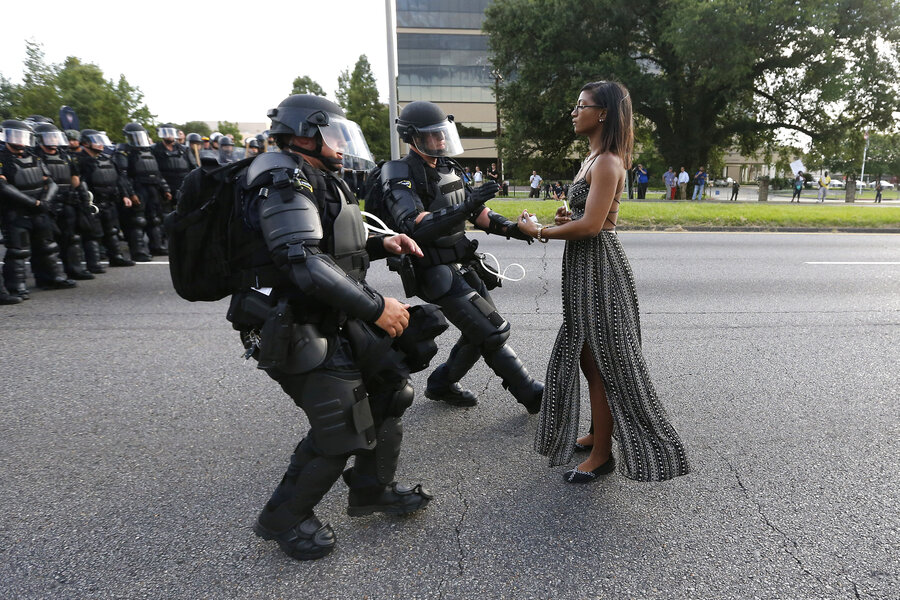What an iconic photo from Baton Rouge protest says about BLM
Loading...
A photo taken during Sunday protests in Baton Rouge following the shooting death of Alton Sterling has gone viral, showing a women's peaceful arrest.
In the photo, the woman, later identified by some media outlets as Ieshia Evans of Pennsylvania, stands peacefully defiant in the street as two officers clad in full riot gear rush toward her during a protest outside the Baton Rouge Police Office.
Freelance photographer Jonathan Bachman told Buzzfeed that it was the first photo he sent to Reuters, as he believed it best represented the message of the protesters. Just days later, the photo has become a symbol of the Black Lives Matter movement.
"You can take images of plenty of people getting arrested, but I think this one speaks more to the movement and what the demonstrators are trying to accomplish here in Baton Rouge," he said.
The protests began after the shooting death of Alton Sterling, a 37-year-old African-American man who was shot and killed by police while pinned to the ground on July 5. Some 150 people were arrested during protests in Baton Rouge over the weekend.
Massive protests – and extensive arrests – have become commonplace following high-profile police shootings of black men by police since protesters took to the streets of Ferguson, Mo., in August 2014. The demonstrations have in some cases tapped a raw anger among black communities.
The movement has coalesced around a fierce yet peaceful defiance, a strategy that echoes the tactics employed by civil rights leaders of decades past, who preached nonviolent resistance in the face of physical force and oppression.
That same peaceful defiance was on display during Black Lives Matter protests in Chicago and Minneapolis last fall, when protesters heeded calls to remain nonviolent, but shirked any pleas for "calm," as The Christian Science Monitor reported at the time.
"The black community is always told to be peaceful, as if we are inherently violent," Charles Preston, who helped organize the protest in Chicago told the Monitor at the time. "The cops ... come and greet these peaceful protesters with militarized gear. The cops come prepared to arrest people who are protesting. The cops have their hands on their guns and they are agitating the situation. ... I think in a situation like that we show great restraint."
The majority of protesters who have taken to the streets in the past week have done so peacefully, though violence did mar some events. Shortly after the conclusion of an event in Dallas, a man shot 12 police officers, killing five and wounding seven others before he was killed by police on Thursday night. The shooter, who died during the attack, was a 25 year-old former Army reservist drawn to two extreme black power groups that have advocated violence, as The New York Times reports.
As the image of Evan's peaceful protest has gone viral, activists online have praised it as emblematic of the soul of the BLM movement, amid worries the violent attack in Dallas may create a roadblock to further progress.
After activist and New York Daily News writer Shaun King shared the photo on Facebook, one commenter declared the image a "legendary" picture that "will be in the history and art books from this time."
"She is balanced, powerful, upright and well grounded with both feet firmly planted on the earth... She is only protected by the force of her own personal power," the commenter wrote. "By contrast, the officers have the transitory, temporary, protection of their equipment that will be removed at the end of their shift. They are rocked back on their heels, knocked off balance, and appear about to fall over backward, just from the power of her."
A group of protestors had blocked a highway in front of police headquarters, Bachman told The Atlantic. Police had cleared most of the protestors off the road when Bachman saw the woman on the road and immediately swiveled to photograph her.
Online commenters compared the photo to historic protest photos, such as the famous photo of the man standing in front of a tank in Tiananmen Square, or the photo of the student crying over a dead friend at Kent State in 1970.
Others pointed to more recent photos, such as the photo of Ferguson protestor Edward Crawford throwing a tear gas canister back at police in 2014, and a photo of activist Maria-Teresa Asplund confronting neo-Nazis in Sweden in May.
This photo of Evans comes days after a video shot by Diamond Reynolds after her fiancé Philando Castile was killed by a police officer went viral. For many, Evans' calmness echoes Ms. Reynold's shockingly poised demeanor while her Mr. Castile lays dying beside her. Such images can have a profound ability to shape national thinking, George Ciccariello-Maher, a political scientist at Drexel University in Philadelphia, told the Monitor earlier this week.
"Images catalyze resistance and offer striking turning points, from Emmitt Till to Rodney King to the present," he said.






